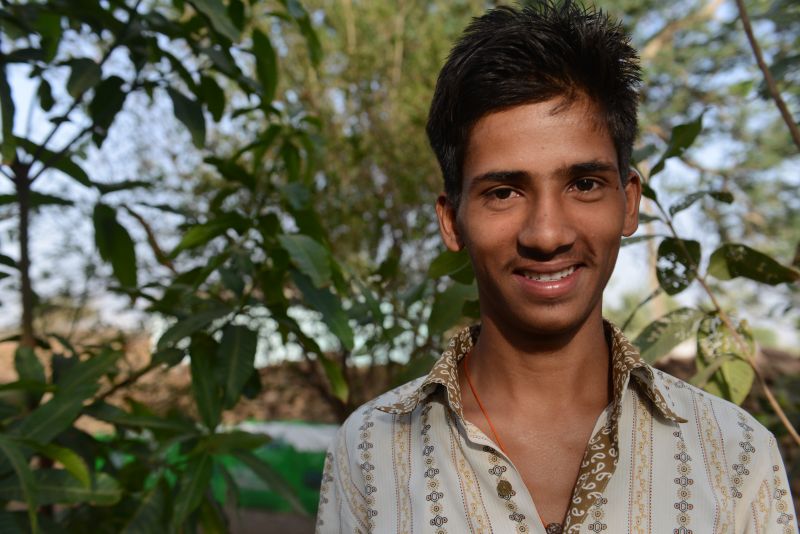
Gone with the trees but bringing back winds of change
August 30, 2016
Words by Annila Harris – World Vision India
Part one of a two part series looking at trees in India and a World Vision special climate change project. This is the story of Prakash (pictured above) and his account of what can happen when the trees are destroyed, and what it takes to bring them back.
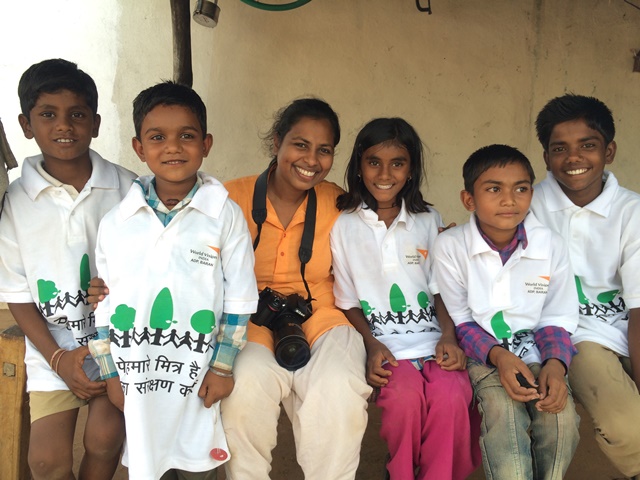
Annila Harris – centre with children from the climate change project
History presents a detailed record of each event, good or bad, that has occurred over a period of time.
The ability of a subject to evoke the past is the reason why I love it so much. Trees were a big part of my village history. Jammun and other fruit trees were scattered all across the area. My dad used to say all that one could see was the colour green, as the trees covered most of the area, it was difficult to see through the thick foliage. Wherever we dug the water gushed out from the ground. There were ponds everywhere. Water shortage was a concept alien to our village of Khankra, Kishanganj, Baran. A symbol of life, the forest brought rain for our land. For my father, a farmer, rain and water were important for the growth of the crops.Each year we had two crop yields.
Teeming with different kinds of wildlife and tree species, the forest was a vibrant author of folklore and stories, a true source of entertainment for us children. Growing up our father used to narrate tales of tigers coming into our village.
One day, he said, the tiger came and ate a calf. The next day, they saw a half eaten carcass of the calf lying outside the neighbour’s house. The forest not only provided shade, it unified the village as one. People met under the shade of the trees to talk to one another. They took time out to bond with one another. People were prosperous back then and during festivals the entire village celebrated together.
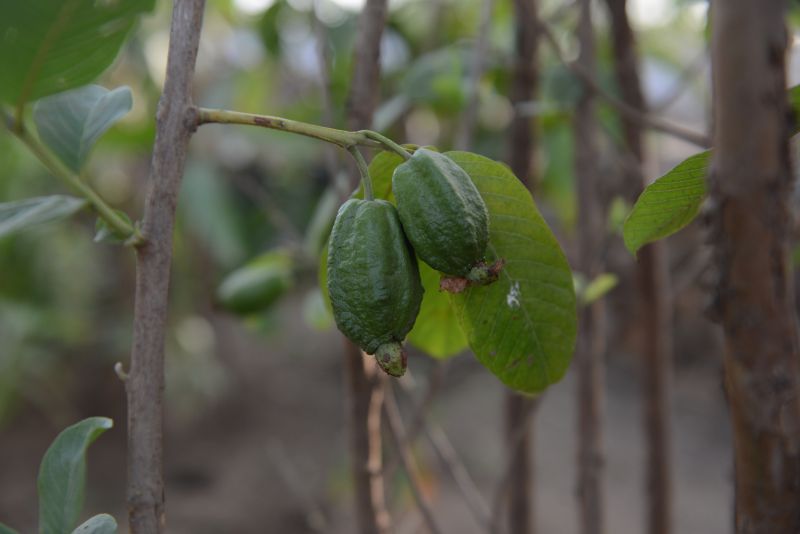
But now the forest is all gone as the trees were hacked one by one. It was only after their demise, we villagers realised the repercussions of our actions. Firewood was the need of the hour. It was the fuel that ignited our conventional stoves. The journey to collect the firewood was a daunting one. It started with a three kilometre long walk. I accompanied my father each time he went to collect fire wood. Whatever we gathered the whole day, we brought back home in the evening.The 2-3 day process was a full day affair and encompassed working in sweltering summer heat. There were times I developed blisters in my hand due to the constant use of the axe.
The exhaustion of withstanding a full day in the harsh heat took its toll on me. I remember that day very clearly, when I was hit by heat wave. My body was boiling hot and in excruciating pain. My parents had to dab my body with wet cloth to get the body temperature down. Falling sick due to a heat stroke kept me away from school for a few days. Fatigued and exhausted I was unable to focus much on studies.
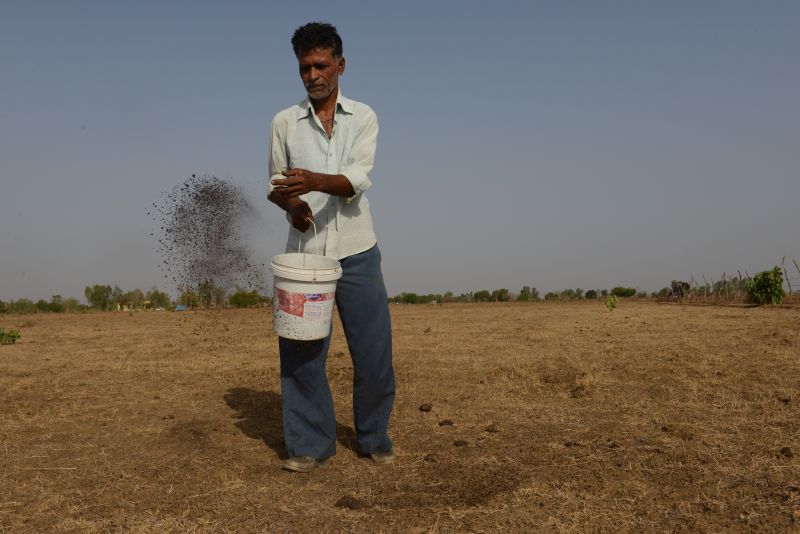
Every time we cut a tree, I did feel sad. They were living beings like us. If they could speak they would say please save us, don’t cut us. But the villagers needed wood.When we brought the wood back home mother would gather some and start a fire in the traditional clay stove. The clay stove was the tree’s final resting place. It felt like the tree was being cremated there. The smoke from the fire used to spread in the air throughout the house and cause pollution. Catching my eye, the smoke used to cause intolerable burning sensation. But for my mother, the smoke was deadly. She had breathing problems and the smoke aggravated her condition. Following the same routine each day my mother drenched with sweat, after spending hours in front of the fire, cooking, used to lie down because the smoke suffocated her and she felt weak. Once we almost lost her. She was unable to breathe; we had to rush her to the hospital.
As the tree density reduced so did the rain. It slowly started affecting the level of ground water. Water started evading us by going deeper into the ground. Desperate in search for water farmers in the nearby villages started using bore-wells. Most of our ponds dried up. The water table went deeper down. The scarcity of water adversely affected our village. My father found it a major challenge to irrigate his land. The land started losing its fertility and the yield drastically dropped from two annual produces to one. Less yield meant less money, soon financial problems inflicted our household.
This is the story of most of the villagers. People no longer had time to sit together and enjoy each other’s company. They were all busy trying to find more means of survival.
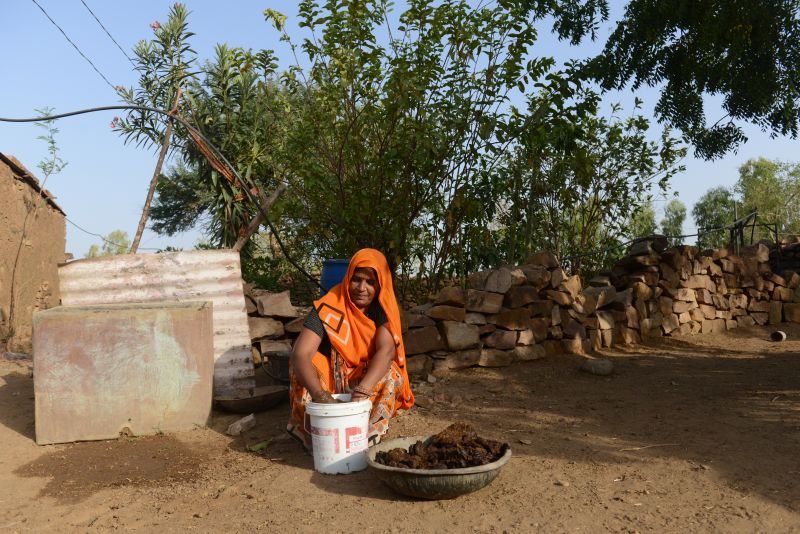
I wish the green would come back. Greenery brought prosperity to our village. Tress brought rain which is important for crops. More rain means more productivity which leads to an improved livelihood. It is a continuous cycle that got disrupted.
In one of the World Vision sensitisation programmes, the children of the village were given awareness on this cycle. I was a fifteen-year-old back then and I too was a part of the programme. We learnt that we should be guardians of trees and plant more trees. I realised how cutting of trees leads to an imbalance in the ecosystem, which leads to drought, food security issues, environmental change, pollution and lack of water.
Each child was given a workbook that had information on how we could know our environment better and why trees are important. We had to identify the different species of trees that are left in our region and elaborate upon its importance. It was really interesting to travel distances to gather information about the trees. With every species I identified, I got a leaf and stuck it in my workbook.
At the programme, we also got tree saplings to plant. I got guava and mango saplings. It was my responsibility to care for these younglings. Three years ago, I planted them near my home. Before going to and after coming back from school I watered them. Now they have grown tall. The guava tree has started giving fruit but the mango tree needs to grow more first before it bears fruit. We couldn’t afford to buy fresh fruit but now my very own trees supply fresh fruit. The awareness programme sparked my interest in growing more trees, so I planted jamun and pomegranate. Now the trees provide much needed shade to my house. It is a great respite from the heat. When I sit inside my house to study, I can get the cool breeze because of the trees.

Each day we learn to value the trees that are left behind. Our household no longer cuts trees for firewood anymore because World Vision gave us a bio-gas unit. The daylong task of collecting wood is no longer needed so I do not have to skip school anymore. The unit runs on cow dung. In the morning the cow dung is made into a semi-solid paste and then fed into the unit, where gas is produced. The gas fuels the kitchen stove. There is no emission of smoke which is good for my mother’s health. Her respiratory problems have reduced. It makes me happy that we are not polluting the environment anymore. Our kitchen walls are no longer covered with the black soot from the smoke. Smoke no longer overpowers the smell of food.
World Vision also organised trainings for my father and other farmers on how to convert bio-gas waste, slurry, into fertilizer that can be used in the field to improve the quality of the soil. They were also given vermicomposting kits.The slurry is put in a trough every day. In the trough there are earthworms that convert slurry into good quality natural fertilizer. Now, the money we spend on purchasing chemical fertilizer has reduced because we are now producing our own fertilizer. Whatever organic fertilizer is excess we sell and earn an additional income.
I have started using the vermicompost fertilizer for my trees and this is the first year when my father put the organic fertilizer in the field before planting the crop.
We are expecting a good quality yield this year.
Now I see the connection in everything we do to preserve the environment. One day my village will be green and prosperous again.

Technical Expert comment:
“The purpose of the climate change project is to promote an environmentally sustainable development approach in the rural context that is low on carbon emissions, and also protects & improves the tree cover of the area. The tree cover is improved by reducing the use of firewood, planting more trees and safeguarding the existing foliage. This requires a multipronged approach at the community level. Children, being the future of tomorrow, have to be sensitised about the causes and consequence of environmental degradation and climate change, how it affects their lives and the world around them. Sensitising children transforms them into future guardians of their natural vegetation. This process is also followed for community members. Apart from sensitisation, to eliminate dependency on firewood, bio-gas units are given to households so that they can optimally utilise the raw materials present in their home to produce clean fuel to run their kitchen. A household having 3 to 4 cattle, cows or buffalos, can easily meet the raw material requirement to power a 2 cubic bio-gas unit. The fuel produced is clean, reduces indoor air pollution and the risk of developing acute respiratory infections (ARI), particularly among infants, and creates a healthy indoor environment. Another added advantage of the bio-gas unit is that the waste produced called slurry can be converted into organic fertilizer through the Vermicompost process. The organic fertiliser, vermin-compost, is good for improving soil quality and is a good source of nutrient supply for the plants. Farmers using Vermicompost are able to reduce their production costs, as they are no longer dependent on chemical fertilizer and produce organic and good quality crop. Prakash’s household is one of the many good examples, where the project interventions have reduced the carbon emissions, promoted the growth of trees, contributed to the household food basket, produces organic manure through materials available in the house and also enables economic benefit,” says Salmon Jacob, Advisor – Environment (Climate Change), World Vision India.
